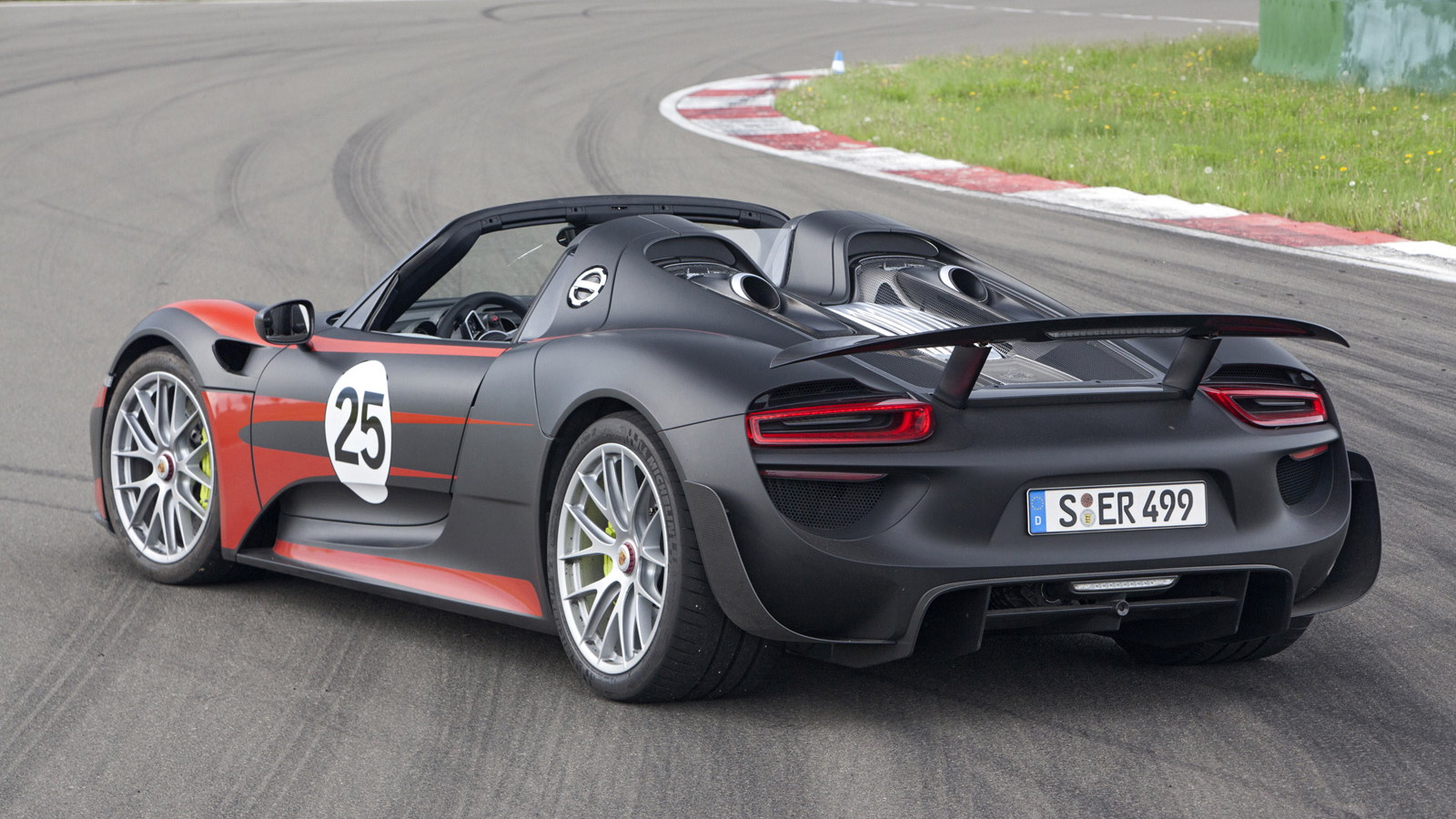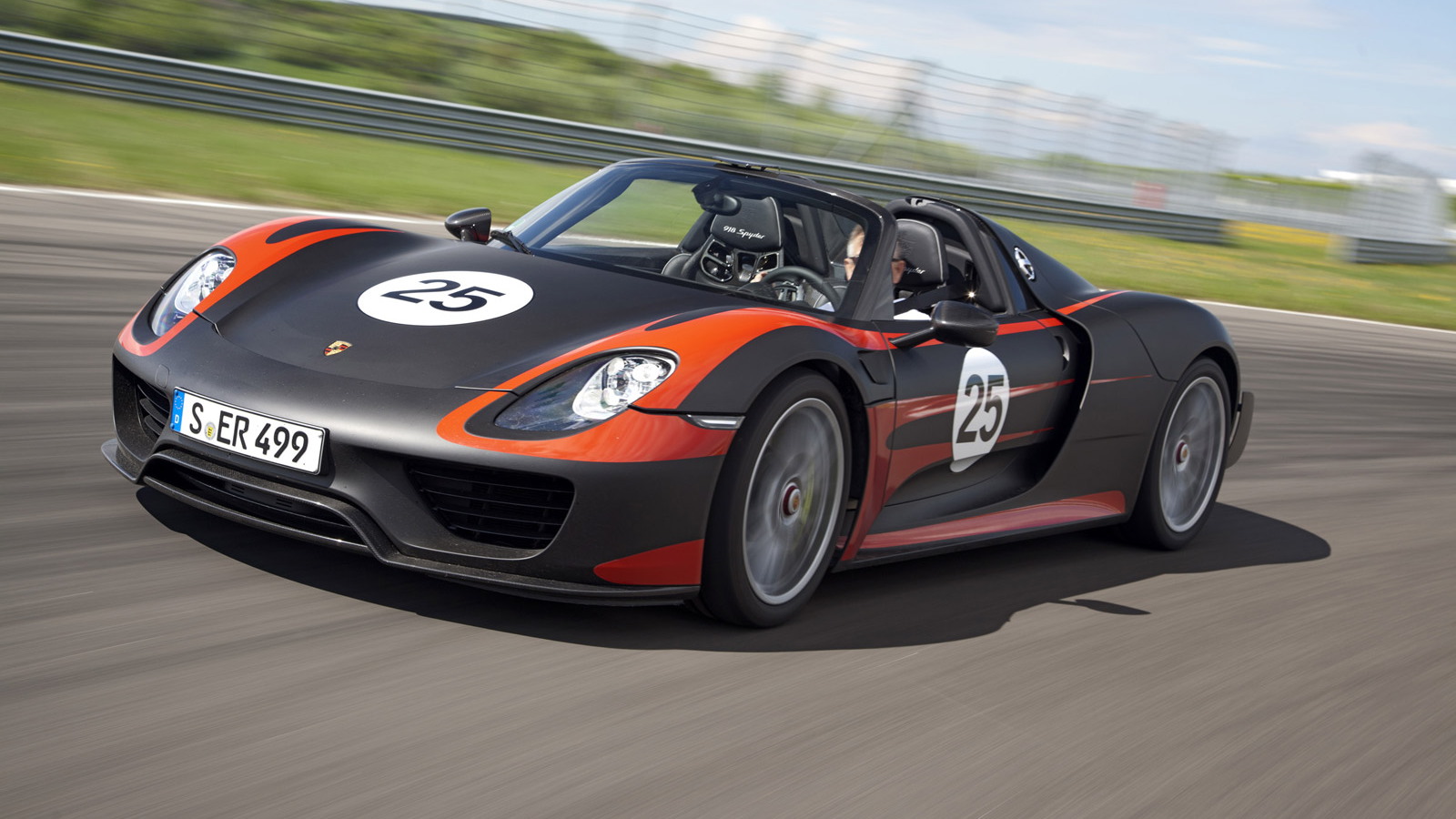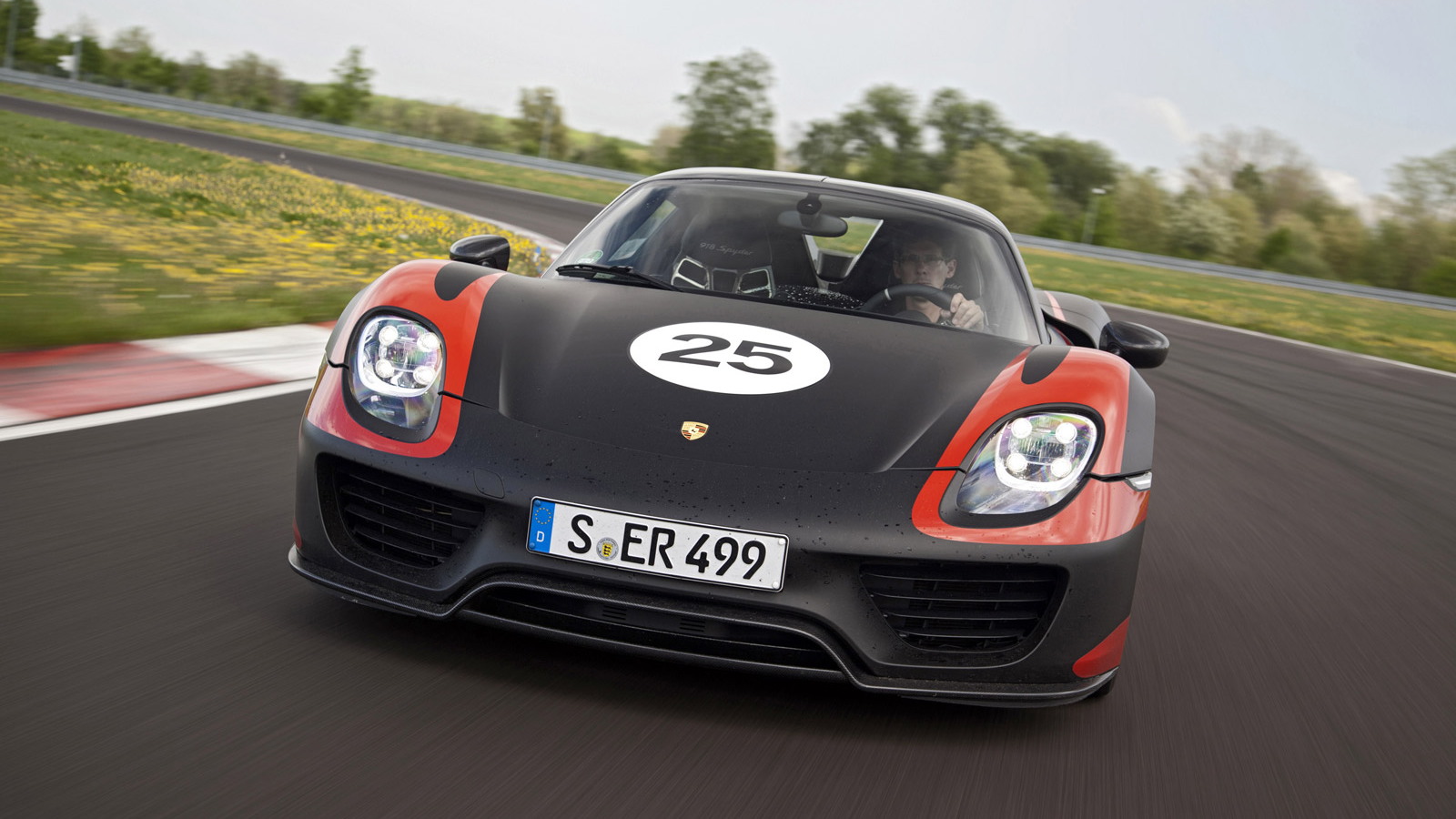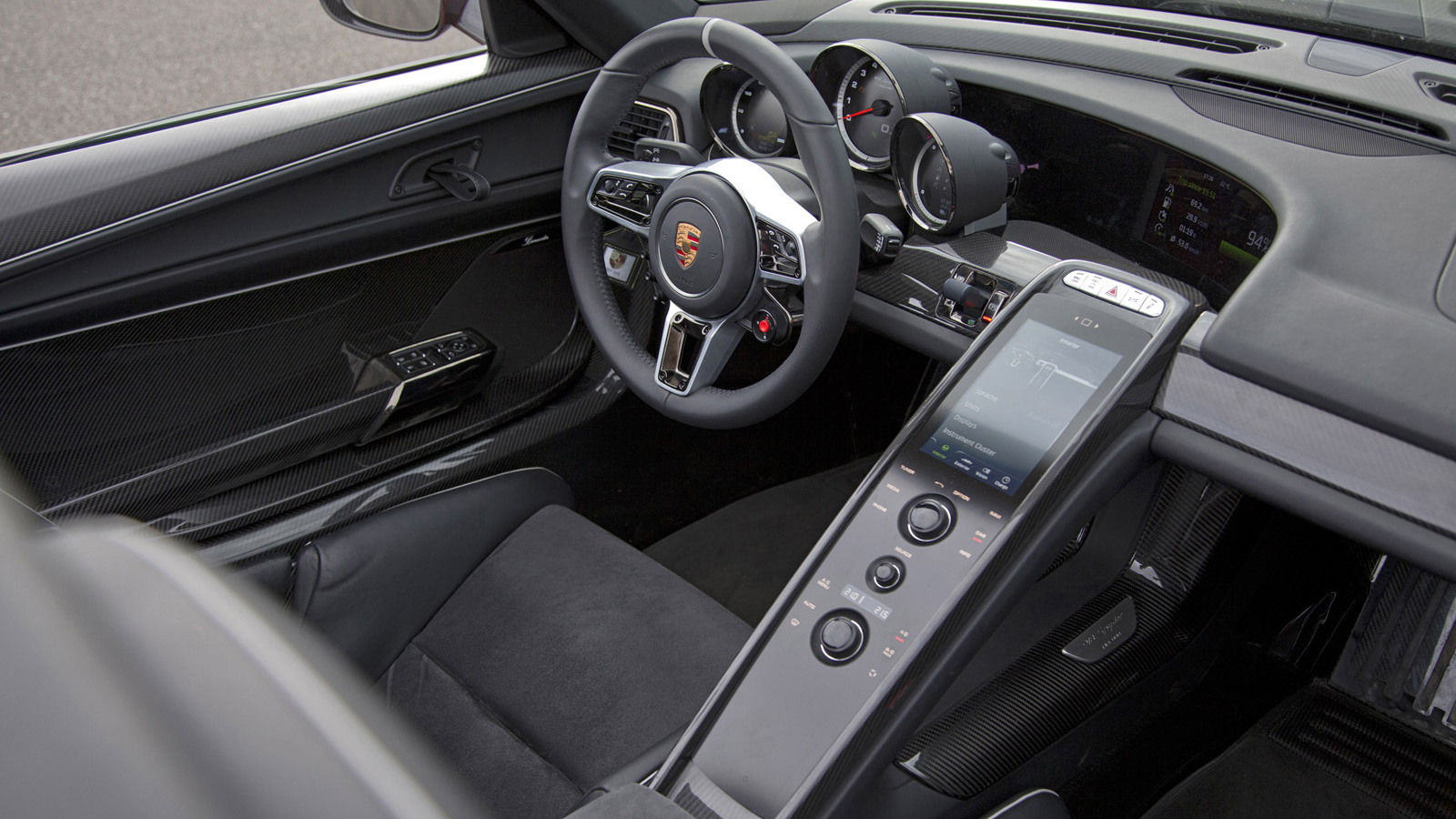The sports car manufacturer has now formally announced full details for the 918 Spyder and revealed for the first time a production-spec prototype. The biggest difference between this prototype and previous examples are the lights, which are now the same units that the production version will feature.
The key goal in the car’s development is the parallel improvement of both efficiency and performance without one being at the cost of the other, but how Porsche has gone about it is very different to anything we’ve seen yet from the company.
Porsche 918 Hybrid Is No Lightweight
At the core of the 918 Spyder is a monocoque chassis, constructed from lightweight carbon fiber reinforced polymer. Unfortunately, the weight of the hybrid system means the 918 Spyder still weighs a portly 3,715 pounds (an available ‘Weissach’ package brings that figure down to 3,616 pounds).
Still, while its rivals may weigh less than 3,000 pounds, the 918 Spyder has the advantage of an all-wheel-drive system, in this case a through-the-road setup made possible by the car’s hybrid system. A race-bred 4.6-liter V-8 is paired with an electric motor and seven-speed PDK dual-clutch transmission and spins the rear axle, while a second electric motor is used to spin the front axle.
The engine produces 608 horsepower on its own and screams to 9,150 rpm. It is based on the design of the racing engine found in the successful RS Spyder Le Mans prototype and also features lightweight components made from carbon fiber. The two electric motors produce 154 horsepower (rear) and 127 horsepower (front), respectively. System output for the 918 Spyder is a staggering 887 horsepower and 940 pound-feet of torque.
Five Modes To Choose From
The car’s hybrid setup enables multiple driving modes, E-Power, Hybrid, Sport Hybrid, Race Hybrid and Hot Lap, all of which are accessed using a control on the steering wheel.
When the vehicle is started up, the all-electric E-Power mode is the default setting. In ideal conditions, the 918 Spyder can cover approximately 18 miles in this mode (charging takes approximately 7 hours using a household plug). Even in all-electric mode, the car accelerates from 0-62 mph in seven seconds and can reach speeds of up to 93 mph. In this mode, the combustion engine is only used when needed. If the battery’s charge state drops below a set minimum value, the vehicle automatically switches to hybrid mode.
In Hybrid mode, the electric motors and combustion engine work alternately with a focus on maximum efficiency and minimum fuel consumption.
In more dynamic situations, there is the Sport Hybrid mode. The combustion engine now operates continuously and provides the main propulsive force. In addition, the electric motors provide support in the form of electric boosting or when the operating point of the combustion engine can be optimized for greater efficiency.
For track work, Porsche engineers have developed a Race Hybrid mode. Here, the combustion engine is chiefly used under high load, and charges the battery when the driver is not utilizing its maximum output. Again, the electric motors provide additional support in the form of boosting. Furthermore, the gear-shifting program of the PDK is set up for even sportier driving. In contrast to the Sport Hybrid mode, the electric motors run at their maximum power output limit for a short time for better boosting.
Finally, there is the Hot Lap mode. Here, everything is turned to the max and the battery is no longer charged so that the combustion engine can focus purely on driving the wheels. This mode is designed for setting lap records.
Nürburgring Lap Time Under 7:14
When in the Hot Lap mode, Porsche is confident the car will beat the previously quoted 7:14 figure 'Ring time, and some are even suggesting it may crack the 7 minute barrier. Importantly, Porsche is confident the 918 Spyder will be quicker around the famous track than its rivals because of its all-wheel-drive system and some other advanced chassis technologies.
One of these is a four-wheel steering system already showcased on the latest 2014 Porsche 911 Turbo. Basically, this incorporates an electro-mechanical adjustment system at each rear wheel. The adjustment is speed-sensitive and executes steering angles of up to three degrees in each direction.
At low speeds, the system steers the rear wheels in a direction opposite to that of the front wheels. This makes cornering even more direct, faster and more precise, and it reduces the turning circle for easy parking. At higher speeds, the system steers the rear wheels in the same direction as the front wheels. This significantly improves the stability of the rear end and is said to make the wheelbase feel like that of a shorter car.
The benefit of all this technology, according to Porsche, is that drivers of the 918 Spyder should be able to brake much later going into a corner than those behind the wheel of a conventional rear-drive supercar.
In addition, the 918 Spyder features its own active aerodynamics. Here, there are three modes, with the most potent being a Race mode. A spoiler positioned between the two wing supports near the trailing edge of the airflow extends. Furthermore, two adjustable air flaps are opened in the underfloor in front of the front axle, and they direct a portion of the air into the diffuser channels of the underbody structure, helping to increase downforce.
Double-wishbone suspension is fitted up front and a multilink setup is used in the rear, with adjustable dampers at both ends. An electro-mechanical setup is used for the steering and the brakes are carbon ceramic discs measure up to 16 inches in diameter.
Final Numbers
For the 0-60 mph run, owners can expect the 918 Spyder to take just under 2.8 seconds, hit 124 mph in 7.9 seconds and pass 186 mph in 23 seconds. It is this last number that has performance fans wondering, as McLaren has quoted a time of 17 seconds for the 0-186 mph run and Ferrari a mindboggling figure of 15 seconds.
We can’t wait until the first showdown.
Only 918 examples of Porsche's new supercar will be built, with production set to commence in September. Each has a starting price of $845,000.
_______________________________________






